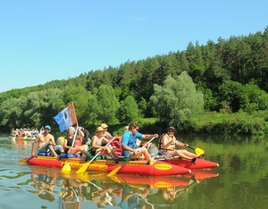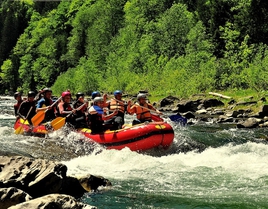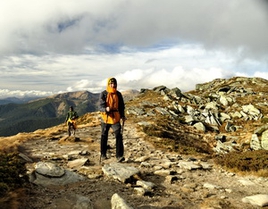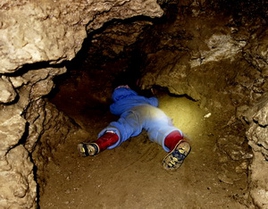Cavern Blue Lakes
One and a half of year in the cavern

In the picturesque area on the south of Ternopil region, near Bilche-Zolote village the cavern Verteba is situated, it's a nature memorial of republic value. In October 1942 38 local citizens from Strilkivtsi village was escaping from the Germans and hide in it. So the nature creation became the shelter for people. There wasn't water in cavern, so the refugees had to came out for it to the well in a village. It was very dangerous and difficult. It became easier when the snow began and they could gather it and melt. In winter where and there water drop from the ceiling of cavern and people put dishes under it was gatherin the water.of Ternopil region, near Bilche-Zolote village the cavern Verteba is situated, it's a nature memorial of republic value. In October 1942 38 local citizens from Strilkivtsi village was escaping from the Germans and hide in it. So the nature creation became the shelter for people. There wasn't water in cavern, so the refugees had to came out for it to the well in a village. It was very dangerous and difficult. It became easier when the snow began and they could gather it and melt. In winter where and there water drop from the ceiling of cavern and people put dishes under it was gatherin the water.
On the night of May 1, 1943 38 persons carefully moving went down underground, there were children, women among them (the oldest was 75). They equipped the hall in the cave, kitchen with a stove.They brought firewood from the Yasynovatyy forest situated near it. As I managed to find (about what the inhabitants of the cave didn't know), the stove was located in an exceptionally successful place, so that the smoke from it flew in a big low horizontal hall formed after the layer cleavage. All soot settled here, so the smoke wasn't visible on the surface.
At night they dug potatoes in the fields, beet, plucked fruits from the trees. They lived during six monthes such. Fascits found out about it location and destroyed the entrance in cavern. People were buried alive in the cavern. But they didn't lost their hearts, and began to dig the way up. During digging they dressed bags on their heads for earth didn't flake off their heads. The maid a ladder from boards and broke through!
New exit was in the distance about 500 m from the old one. To Germans didn't find it, it was covered by the box with earth. To make the climbing from it more comfortable they hung there a chain stolen from deep well in a village.
But it was dangerous to stay in the cavern more. Then 5 men found a funnel in Strilkivtsi village, which in that time was called Pope Pit. Nowadays on the bottom of this funnel there is an entrance in 111 kilometres labyrinth of the nature memorial of republican values - call Ozerna cave. There wasn't a present entrance then, but there was a hole in the centre of the funnel. People went down in it and were in the not big underground chamber. The manhole dug-out by fox began from it.
Tje first one who entered the cave was Nyselhterman, then his brother Shulko, brothers Mendel and Yuzef Dodek, and also Karl Kurts. Passed several dozens metres, they came to the lake with spring water. They called it Black Pond.

To go out on the surface was very dangerous, because the fascists could watch there. Only young boys came out on the surface to find some food. They cast lots - who had to go out the first. The first one before getting out of the cave, pulled out the scarecrow outside which was attached to the stick to check if Germans shoot. They came out only at nights. Anyone hadn't the wathes, because everybody were very poor. But they learned to determine the time watching for Big Dipper stars location, which were visible for them in a hole of entrance. When they returned to cave, they sounded the prearranged signal, because the guard with peacks watched below. They pulverized cereal ears gathered by them, baked the azyme and lived verry happy, didn't sad. The life was here, underground, and on the surface the death stalked everywhere. The temperature in tha cavern is 10 degrees above zero during all year. So the inhabitants of the cave didn't freezed, they walked barefoot and none of them didn't get sick. For lighting they used kerosene lamps.
Among local citizens Semen Panlo with his brother, Kovalsky family and Munko Labudzyn helped them. During one sally in the surface they heard the shootin far, that meaned that Red Army came. Two of them went to the village, but they were captured by Germans and died. Only after two weeks Munko Labudzyn them a note in a bottle attached to rope about that the Germans had gone.
So on April 12, 1944, almost after half year of their living in a cave everyone came out on the surface. Five year girl pointing on sun and closing tha face by her hand shouted: "Turn off the light!".
Later almost all of them moved to Canada. Only in summer 1991 the most of these people came to their motherland. I met them accidentally and heard this story, whis has almost 50 years.
Yuzef Zimels
Copyright (c) Zimels Y.L.
Copyright (c) Kyiv karst and speleological centre, computer version, 1993
Address: Ukraine, 252030, Kyiv-30, s/b 224/8




